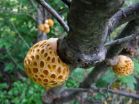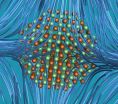(Press-News.org) MADISON, Wis. — As one of the most widely consumed and commercially important beverages on the planet, one would expect the experts to know everything there is to know about lager beer.
But it was just a few years ago that scientists identified the South American yeast that, hundreds of years ago, somehow hitched a ride to Bavaria and combined with the domesticated Old World yeast used for millennia to make ale and bread to form the hybrid that makes lager or cold stored beer.
The mystery of the cold-adapted yeast that blended with a distant cousin to make the lager-churning hybrid endured for almost 500 years and is emblematic of the biological black boxes that drive much of industrial fermentation, even in an age when fermentation underpins the production of everything from soy sauce to biofuel.
Now, however, scientists are beginning to color in the margins of yeast ecology and genetics, identifying new strains in new environments and using the tools of molecular biology to ferret out traits that could aid industrial fermentation technologies. Writing today in the journal Molecular Ecology, a team led by University of Wisconsin-Madison Professor of Genetics Chris Hittinger confirms that Saccharomyces eubayanus, the wandering parent of hybrid lager yeast discovered in 2011, is indeed a native of Patagonia. An analysis of the yeast's genetic sequence revealed its closest affinity to one of two highly diverse Patagonian populations, confirming it was the cold-loving microbe that, 500 years ago, found its way to the caves and monastery cellars of Bavaria where lager beer was first concocted.
"This yeast really is native to Patagonia," explains Hittinger, who was part of the international team that discovered Saccharomyces eubayanus three years ago. "We found two major populations that seem to be distinct. The trees they're associated with seem to provide everything they need. They're happy there."
Hittinger's colleague, Diego Libkind of the Institute for Biodiversity and Environment Research in Bariloche, Argentina, and a co-author of the new study, has conducted extensive field surveys, combing the Patagonian landscape where the cold-adapted yeast that he discovered seems to occur at a very high rate.
Despite their prevalence in Patagonia, the new study provides evidence that they are no longer exclusive to South America. Hittinger and his group also discovered Saccharomyces eubayanus, with genetic hallmarks of the Patagonian strains, in a single North American location: Indian Mound Park, near Sheboygan, Wis. It is the first time the microbe has been found in nature in North America, or indeed outside of Patagonia. Found by UW-Madison undergraduate student Kayla Sylvester, a member of Hittinger's group, the yeast occurs only at a very low frequency and was likely accidentally introduced, just as an ancestor found its way to Europe and kick-started the production of cold-brewed lager beer hundreds of years ago.
"If I had to bet, I'd lay money on ski bums or migrating birds" as the agents responsible for transporting the microbe to Wisconsin, says Hittinger. "What we think is happening is that well-established, genetically diverse populations are sending migrants around the world. Generally, they're not successful, but occasionally they are."
Thankfully, Saccharomyces eubayanus met a match in Europe to form the lager hybrid. The world's 1,500 or so described yeasts are masters of what scientists call reticulate evolution, the ability to add traits by hybridizing or otherwise combining different species. Although rare in nature, the huge populations and strong selection that exist in industrial fermentations allow even rare hybrids to be recovered, if they are favored.
By exploring yeasts' native habitat and looking to see where else in the world they have turned up, scientists may unlock secrets of yeast genetics and hybridization with enormous economic benefit.
"Yeasts are important for fermenting processes and biotechnology," notes genetics graduate student David Peris, also of UW-Madison and a co-author of the new study. "The value of studying diversity is that you can pull out genes or strains that can be used for a particular industrial process."
Their primary job in industrial fermentation settings is to break down sugars, converting them to alcohol. The grail of modern industrial fermentation research is perfecting fermentation processes for things like biofuels. Four of the seven known natural Saccharomyces species of yeast are now known to be involved in industrial processes, at least as interspecies hybrids.
"The idea," Hittinger says, "is to tap into biodiversity and find the strains that ferment better and those strains, or their genes, can be plugged into industrial processes."
Brewers and winemakers, he notes, have unwittingly selected for hybrids. The tools of modern biotechnology, he explains, can potentially refine industrial fermentation by mixing and matching genes that lead to a better conversion of sugar to alcohol.
INFORMATION:
The new study was supported by a grant from the National Science Foundation and was funded in part by the Department of Energy-funded Great Lakes Bioenergy Research Center.
—Terry Devitt, 608-262-8282, trdevitt@wisc.edu
NOTE: A high-resolution image to accompany this story can be downloaded at http://www.news.wisc.edu/newsphotos/lagerYeast14.html
Scientists firm up origin of cold-adapted yeasts that make cold beer
2014-04-09
ELSE PRESS RELEASES FROM THIS DATE:
Age does not predict success for those in court-based mental health treatment programs
2014-04-09
COLUMBIA, Mo. – Statistics show that the amount of older adults in the criminal justice system has quadrupled in the past 15 years. Many of the adults have histories of mental health problems and are being placed in court-based treatment programs, where government officials and social workers tend to think that they are more likely to experience success compared to their younger counterparts. However, new research by Kelli Canada, assistant professor in the University of Missouri School of Social Work, shows that although mental health court participants older than 50 adhere ...
TGen identifies growth factor receptors that may prompt metastatic spread of lung cancer
2014-04-09
PHOENIX, Ariz. — April 9, 2014 — Two cell surface receptors might be responsible for the most common form of lung cancer spreading to other parts of the body, according to a study led by the Translational Genomics Research Institute (TGen).
The hepatocyte growth factor receptor (HGFR/MET) and fibroblast growth factor-inducible 14 (FN14) are proteins associated with the potential spread of non-small cell lung cancer (NSCLC), according to the TGen study published online April 8 by the scientific journal Clinical & Experimental Metastasis.
NSCLC represents more than 85 ...
Are chromium supplements helpful in lowering blood sugar levels?
2014-04-09
Coral Gables, FL (April 9, 2014) -- Approximately 26 percent of the U.S. population has impaired fasting glucose, which is a predisposition for developing type 2 diabetes, and chromium supplementation has been suggested as a method that may help control and prevent the disease.
A new study by a University of Miami (UM) researcher analyses nearly three decades of data on the effect of chromium supplementation on blood sugar and concludes that chromium supplements are not effective at lowering fasting blood sugar in healthy individuals, or diabetics.
Chromium is a mineral ...
Emerging research suggests a new paradigm for 'unconventional superconductors'
2014-04-09
An international team of scientists has reported the first experimental observation of the quantum critical point (QCP) in the extensively studied "unconventional superconductor" TiSe2, finding that it does not reside as predicted within the superconducting dome of the phase diagram, but rather at a full GPa higher in pressure.
The surprising result, reported in Nature Physics, suggests that the emergence of superconductivity in TiSe2 isn't associated with the melting of a charge density wave (CDW), as prevailing theory holds; in fact the CDW's amplitude decreases under ...
The motion of the medium matters for self-assembling particles, Penn research shows
2014-04-09
By attaching short sequences of single-stranded DNA to nanoscale building blocks, researchers can design structures that can effectively build themselves. The building blocks that are meant to connect have complementary DNA sequences on their surfaces, ensuring only the correct pieces bind together as they jostle into one another while suspended in a test tube.
Now, a University of Pennsylvania team has made a discovery with implications for all such self-assembled structures.
Earlier work assumed that the liquid medium in which these DNA-coated pieces float ...
New climate pragmatism framework prioritizes energy access to drive innovation/development
2014-04-09
Drastically improved efforts to provide modern energy access to the poor opens up a new approach to development efforts and action on climate change, an international group of energy and environment scholars say in a new report, Our High-Energy Planet. The report is the first of three in the Climate Pragmatism project, a partnership of Arizona State University's Consortium for Science, Policy, and Outcomes (CSPO) and The Breakthrough Institute.
"Climate change can't be solved on the backs of the world's poorest people," said Daniel Sarewitz, a report coauthor and co-director ...
Vigilance for kidney problems key for rheumatoid arthritis patients
2014-04-09
Rochester, Minn. — Rheumatoid arthritis patients are likelier than the average person to develop chronic kidney disease, and more severe inflammation in the first year of rheumatoid arthritis, corticosteroid use, high blood pressure and obesity are among the risk factors, new Mayo Clinic research shows. Physicians should test rheumatoid arthritis patients periodically for signs of kidney problems, and patients should work to keep blood pressure under control, avoid a high-salt diet, and eliminate or scale back medications damaging to the kidneys, says senior author Eric ...
Researchers discover dangerous ways computer worms are spreading among smartphones
2014-04-09
VIDEO:
Professor Kevin Du and his team at Syracuse University have identified apps that could cause problems for smartphone users, allowing hackers easy access to sensitive information.
Click here for more information.
Professor Kevin Du and a team of researchers from the College of Engineering and Computer Science at Syracuse University have recently discovered that some of the most common activities among smartphone users—scanning 2D barcodes, finding free Wi-Fi access points, ...
Stanford scientists model a win-win situation: Growing crops on photovoltaic farms
2014-04-09
Growing agave and other carefully chosen plants amid photovoltaic panels could allow solar farms not only to collect sunlight for electricity but also to produce crops for biofuels, according to new computer models by Stanford scientists.
This co-location approach could prove especially useful in sunny, arid regions such as the southwestern United States where water is scarce, said Sujith Ravi, who is conducting postdoctoral research with professors David Lobell and Chris Field, both on faculty in environmental Earth system science and senior fellows at the Stanford Woods ...
Medication therapy management works for some but not all home health patients
2014-04-09
WEST LAFAYETTE, Ind. — Low-risk Medicare patients entering home health care who received medication therapy management by phone were three times less likely to be hospitalized within the next two months, while those at greater risk saw no benefit, according to a study led by Purdue University.
The study helped determine which patients benefit most from medication therapy management by phone and a way to identify them through a standardized risk score, said Alan Zillich, associate professor of pharmacy practice at Purdue, who led the research.
"Hopefully, this study ...




